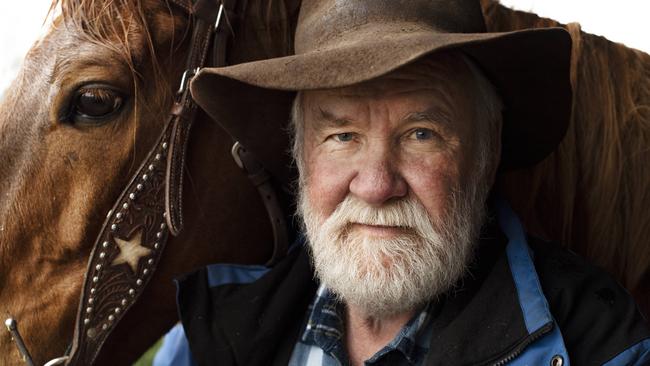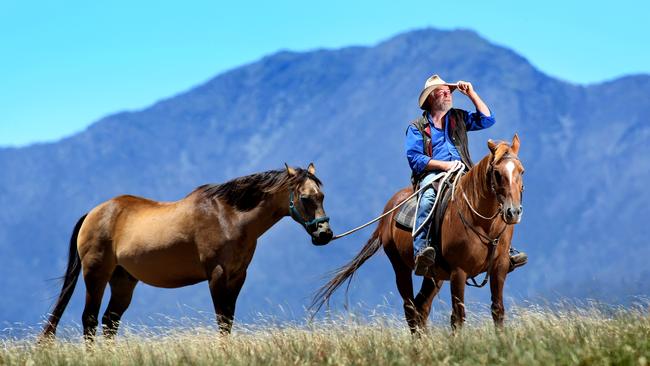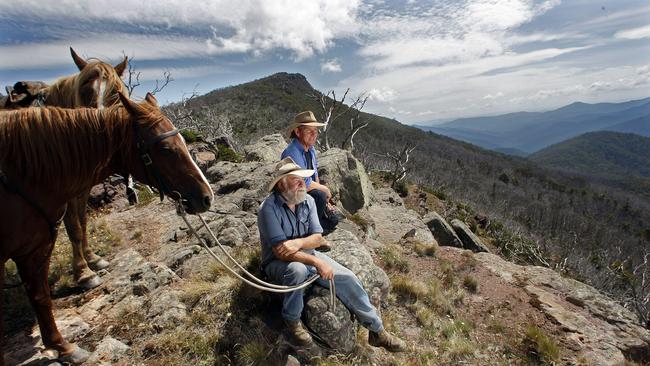Charlie Lovick: High Country legend and mountain cattleman rides again
His skills saw him become the master of horse for The Man from Snowy River films. The iconic cattleman looks back on his incredible life.

Growing up in the foothills of Victoria’s rugged high country, Charlie Lovick never warmed to the four walls of a school classroom.
“My old man didn’t believe in a lot of schooling – he was of the opinion that you shouldn’t let too much schooling interrupt your education,” the iconic mountain cattleman, now 71, says with a cheeky grin.
“When there was a job that needed to be done, he’d drive up in the old Ford, walk through the school – nobody would interfere with him or ask him a question – he would just say to the nearest person ‘Where’s Charlie?’. He’d then walk down to my classroom, talk to the teacher, and say ‘C’mon boy, we’re off’.
“I’d wave goodbye and I was gone. Sometimes we’d be gone for three months, droving cattle.”
The Lovicks were among the original pioneering families of Merrijig, near Mansfield, arriving in the district in the 1860s, and quickly becoming intrinsically linked with the Victorian high country.
Most famously, Charlie’s forebears were among Victoria’s original mountain cattlemen. Each summer, for more than a century, they would muster, on horseback, their cattle up to high country lease blocks on the Great Dividing Range, where they would be left to graze for three months. It was a practice that became immortalised in Australian folklore before eventually being stamped out in 2005 on environmental grounds by the Bracks Labor Government.
“Most families had that early connection to some of these high country leases through their forebears well before there were any licences ever issued or granted, or before government even ever knew what was out there,” Charlie said. “So it became a tradition that those original families retained their leases.”
Charlie said, once gazetted, the Lovicks’ main lease covered about 100,000 acres (40,460 hectares), about 3-5 per cent of which was suited for grazing 200 cattle – traditionally their best mothers with the best heifer calves – for a maximum 20 weeks. An advisory committee, which included mountain cattlemen, was set up to advise the Government on when the country was ready to be grazed.
This was normally around early to mid-December, as the snow thawed and summer rain promoted the growth of grass.
“It was always our contention that you eat the grass as it is growing, not let it get big and rank and then try and eat it,” Charlie said. “And by doing that all that grazing country was left nice and green because it never got the maturity – it was green right through the summer fire season.
“A really big part of that whole design was not just grazing the cattle but managing the country.”

The Lovicks would traditionally spend about five days in the saddle, mustering their cattle to their lease blocks, located 1675m to 1830m above sea level. In the early days, supplies were carried by packhorses but the formation of fire tracks allowed for four-wheel drive backup access which meant “you could actually take a beer”.
During the musters, the Lovicks would mostly sleep out under the stars, in the warm glow of a campfire, or in its traditional mountain hut, built in the late 1950s on Barkly’s Flat. “All cattlemen considered their mountain huts their second home and my old man actually thought it was his first – he’d rather be out there than here,” he said.
Charlie said the family would return to check on their cattle several times during the summer – “you might want to disperse them or check where particular cows were grazing” – before bringing them back down the low country at the end of February.
It was the Lovicks’ passion for the mountains that caught the eye of documentary makers, which then morphed into their involvement in the making of the two popular Man from Snowy River films during the 1980s. Charlie was appointed master of horse, responsible for wrangling the huge cast of horses procured from across the high country for filming as well as finessing the horse skills of the main actors.
Before cameras started rolling, the film’s star, Tom Burlinson, spent three months with Charlie and his family learning how to ride. Charlie remembers leading lady Sigrid Thornton as being “competent without being confident” on a horse while their co-star, Hollywood screen legend Kirk Douglas, “couldn’t ride a bloody broomstick” when he arrived for the start of the 15-week shoot.
The film, Charlie recalls, also involved opportunities for local horseman, “with plenty of heart”, from Omeo, Benambra, Heyfield and Mansfield to show off their unique-yet-competitive skills.
“Every time we were going down those steep hills (during filming) it would be full on,” Charlie said. “There was no way someone from Mansfield was going to let a Connley or someone from Omeo beat him down the bloody hill.
“There would be a bit of roughhouse tactics but every night in the pub you’d all have a beer and laugh about it.”

Sadly, however, Charlie said it wasn’t long before the tide of some public opinion started to turn against mountain cattlemen. “Things started to get a bit hot in the late 1980s … we were threatened”. The once-respected Forest Commission had been disbanded, replaced by government departments that were “more bureaucratic minded than country minded” and claimed cattle were damaging the pristine environment of the high country.
“They never had that connection the Forest Commission had in the bush – they had great knowledge because they were in it all the time,” he said. “The bureaucrats and the academics had no knowledge.
“Those departments were infiltrated by a lot of bushwalkers who didn’t see that the cattle should have been in there at all. But it was all right for us to go and find them when they got lost, or for them to stop in our huts to survive.”
When the Alpine National Park was declared in 1989, mountain cattlemen knew time was nigh. “There were a number of leases lost in the late ‘80s and ‘90s, areas were blocked off, and we could see the writing was on the wall,” Charlie said, adding that “it took a while for them to get rid of us” with the death knell coming in 2005.

“I honestly believe that decision was not about science, it was about appeasing the greens vote,” he said. “It was so unnecessary.” Charlie is now concentrating his efforts on retraining and rehoming former racehorses and seeing the tradition of mountain cattle grazing immortalised in bricks and mortar with a proposed High Country Hall of Fame. He is hoping to raise $5m for its construction at Merrijig.
“Time is running out and the sad thing is that knowledge is quickly disappearing,” he said. “The reality is, without blowing my own bags, unless I do this it won’t ever be done. My personal want is to educate people and kids to their own country.”
To teach them a lesson they can’t get in any classroom.




